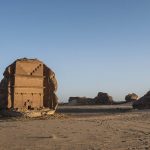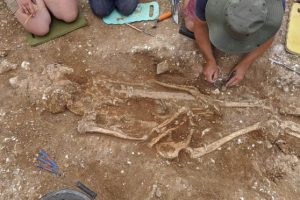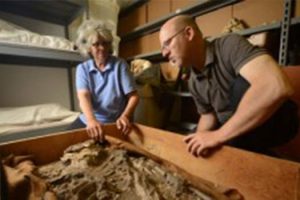 In July, Machu Picchu, Peru’s biggest tourist attraction, will mark its 100th anniversary of rediscovery. Hiram Bingham III, a Yale professor, came upon the vine-covered ruins on July 24, 1911. Here, then, as we lead up to the century mark, are 100-plus facts about Machu Picchu, its country, its history and its players. We’ve been posting one each day for 100 days. Read from the bottom up.
In July, Machu Picchu, Peru’s biggest tourist attraction, will mark its 100th anniversary of rediscovery. Hiram Bingham III, a Yale professor, came upon the vine-covered ruins on July 24, 1911. Here, then, as we lead up to the century mark, are 100-plus facts about Machu Picchu, its country, its history and its players. We’ve been posting one each day for 100 days. Read from the bottom up.
46. In 1533, Atahuallpa was executed, and explorer Francisco Pizarro began his march to Cuzco.
45.Amazingly, Francisco Pizarro’s men, who numbered less than 200, overcame 4,000 or so Incans and captured Atahuallpa, the Incan ruler.
44. In November 1530, Francisco Pizarro and Atahualpa, the Incan ruler, were to meet in Cajamarca, an Incan city in northern Peru. Pizarro told Atahualpa to give himself to Christ and the Spaniards, and when he refused, Pizarro decided to attack.
43. The governor of Panama thought the expeditions foolish, so Francisco Pizarro went to Spain to speak directly with the emperor, who said yes. Off Pizarro sailed.
42. Pizarro and his partner, Diego de Almargo, and a priest, Hernando de Luque, sailed down the west coast of South America twice.
41. Francisco Pizarro seems an unlikely player in that drama. He was a bit of a puzzle. Once, the explorer was marked as unambitious, but after a stint as mayor of a city named Panama (in, not surprisingly, Panama), he turned his attention to South America.
40. Where once there was an Incan empire, now there was a Spanish empire that endured for 300 years.
39. The conquistadors played a huge role in Peru, of course. Led by Francisco Pizarro, they claimed the land for Spain in the 1500s.
38. Did the Spaniards know of Machu Picchu? Hiram Bingham didn’t think so. “Yet so far as I have been able to discover, there is no reference in the Spanish chronicles to Machu Picchu. It is possible that not even the conquistadors ever saw this wonderful place.”
37. Hiram Bingham continued, “Surprise followed surprise until we came to the realization that we were in the midst of as wonderful ruins as any ever found in Peru.”
36. And what, really, could be? Here’s what Hiram Bingham wrote in Harper’s Monthly in 1913 about coming upon Machu Picchu. “… Suddenly we found ourselves in the midst of a jungle-covered maze of small and large walls, the ruins of buildings made of blocks of white granite, most carefully cut and beautifully fitted together without cement.”
35. Hiram Bingham found Vilcabamba, but he dismissed it because it wasn’t as grand as Machu Picchu.
34. Today, historians think the real Vilcabamba is close to Vitcos, an archaeological site, in the eastern Andes. Another swashbuckling explorer, Gene Savoy, came upon it in 1964 at a place called Espiritu Pampa.
33. Hiram Bingham thought he had found Vilcabamba, the true “Lost City of the Incas,” which was said to be where the Incas took refuge from the Spaniards.
32. Columbus, of course, thought he discovered Asia; Hiram Bingham thought he discovered the “Lost City of the Incas.” Both were wrong.
31. Here’s something Hiram Bingham and Christopher Columbus have in common: Both thought they had discovered some other place.
30. Like many explorers, Hiram Bingham didn’t know exactly what he found.
29. Hiram Bingham said in his Harper’s Monthly story, published in 1913, that a “local muleteer” may have been in Machu Picchu in 1902, based on scrawls he found on a wall. It seems clear that even if the Spanish didn’t know it existed, others certainly did.
28. Hiram Bingham may not have been the first European to find Machu Picchu. Some say it was a German named Augusto Berns who came upon it in 1867.
27. Hiram Bingham didn’t really discover Machu Picchu; the residents knew it was there, and a local Quechua-speaking guide, Melchor Arteaga, is said to have led him there.
26. Machu Picchu was, not surprisingly, declared a UNESCO World Heritage site in 1983.
25. When you enter Machu Picchu, you’ll see why it’s been designated one of the best-preserved pre-Columbian ruins in the world.
24. You can go to Machu Picchu and return to Cuzco in a day, but you’ll have more of it to yourself if you plan to stay a night or two. Day trippers usually leave by 2 p.m.
23. Aguas Calientes, which has grown haphazardly as tourist crowds have grown, offers accommodations, some basic and others more luxurious, and is the starting point for the ascent (by bus, if you wish) to the Incan citadel.
22. The train deposits you at Aguas Calientes, at the foot of Machu Picchu (which you’ll see spelled as Machupijchu).
21. In March and April, however, train travelers have been taking a bus from the Wanchaq Station in the Cuzco area, to Ollantaytambo and then taking the train to Aguas Calientes because of maintenance projects with the line.
20. Depending on the level of luxury you desire, your train trip to Machu Picchu could cost as little as $96 from Cuzco (for the Expedition train). It’s $142 for the VistaDome and $668 for the Hiram Bingham.
19. You have three choices of train travel to Machu Picchu: the Expedition, or backpacker train (basic), the VistaDome train (which has lots of windows, but if it’s warm outside, you may feel as though you are baking in a terrarium) and the Hiram Bingham, a luxury train operated by Orient Express.
18. Most visitors take the narrow-gauge train to Machu Picchu from the Cuzco area (usually departing from the Poroy station).
17. The five days’ journey from Cuzco refers to hiking to Machu Picchu, which you can still do today on the Incan Trail, a three- to six-day trip that requires good stamina.
16. Hiram Bingham wrote in Harper’s Monthly in 1913: “It seemed almost incredible that this city [Machu Picchu], only five days’ journey from Cuzco, should have remained so long undescribed and comparatively unknown.”
15.Cuzco, with a population of about 300,000, is the gateway to Machu Picchu, but don’t let the word “gateway” confuse you: Machu Picchu is 50 miles beyond Cuzco near the town of Aguas Calientes, far below the Incan ruins.
14. The symptoms of altitude sickness don’t generally occur until you’re at 8,000 feet. Depending on which yardstick you use, Machu Picchu may be less than that (or more). Some say it’s at 7,100 feet; others say 9,000. Bottom line: Cut yourself a little slack.
13. To help cope with the altitude, make sure you don’t get dehydrated and avoid drinking alcohol.
12. Some hotels provide oxygen for visitors; others offer coca tea, and it’s not unusual to find packets of coca leaves for sale. These can be chewed and are said to help relieve altitude issues. And yes, cocaine is produced from the leaves, but the amount of the alkaloid you’d ingest from the tea or chewing the leaves is small.
11. Among the problems AMS can cause (if you’re coming from sea-level California, be aware of this): headaches, shortness of breath, fatigue and/or nausea or vomiting. Consult a doctor before you go if you think you may have a problem. Symptoms usually disappear in four days, but in some cases, AMS may be fatal.
10. At 11,150 feet, Cuzco requires acclimation. Some people develop altitude sickness, also known as acute mountain sickness, or AMS.
9. Cuzco, sometimes spelled Cusco, means “navel” or “center” of the Earth. It certainly was the center of Inca civilization high in the Andes Mountains.
8. Legend has it that Manco Capac, the son of the sun god, and Mama Ocllo, daughter of the moon, established the seat of what would become an empire at Cuzco in the 11th or 12th century.
7. Much of what we know — or think we know — about the Inca society is hazy and often mixes fact with myth.
6. Because the Incas had no written language system (or one that we have yet figured out), the spellings of original words vary widely. Inca, for example, may be spelled Inka, Ygna or Inga.
5. The Incas, who created incredible architecture and political systems, had no known written system of language, although some scientists suggest khipu may also have served that function.
4. The Inca used khipu (spelled “quipu” in Spanish), a series of knots that functioned as a sort of counting system.
3. About half the population of Peru is Quechua, a South American Indian group. The group’s native tongue is also called Quechua. A dialect of that language was spoken by the Incas.
2. Peru shares borders with five countries: Ecuador, Brazil, Bolivia, Chile and Colombia.
1. At 496,218 square miles, Peru, in western South America, is about the size of three Californias. California, however, has about 8 million more residents than Peru.
By Catharine Hamm Times Travel editor
May 30, 2011















Fastidious replies in return of this difficulty with genuine arguments
and describing all concerning that.
Ich habe natürlich damit begonnen, die Inhalte nach und
nach zu erweitern und zu ergänzen.
Welcome to our coach online store,Super Discount waiting for youCoach Purses
On Sale Coach Purses On Sale
Thanks , I’ve just been looking for info approximately this topic
for ages and yours is the greatest I’ve found out till now.
However, what about the bottom line? Are you certain about the supply?
Es schützt Ihre Website vor unbefugten Veränderungen.
I don’t even know how I ended up here, but I thought this post was good.
I don’t know who you are but definitely you’re going to a famous blogger
if you aren’t already 😉 Cheers!
Hi! I could have sworn I’ve been to this site before but after checking through some of the
post I realized it’s new to me. Nonetheless,
I’m definitely happy I found it and I’ll be book-marking and checking
back often!
Auf diese Weise kann z. B. die Shiatsu-Massage nachempfunden werden.
Your eyes and your sub-conscious will notice a stack of fives and tens more than it will notice a single
fifty and will put a higher value on them. ” He finishes his chastisement by accusing the Queen of leaving a fair mountain to reside on a moor. Even when you want her to change or improve on a situation or behavior, praise and tenderness will make it easier for you to accomplish it rather than being mean and critical.
It’s enormous that you are getting thoughts from this
piece of writing as well as from our discussion made at this time.
Link exchange is nothing else except it is just placing the other person’s weblog link on your page at appropriate place and other person will also do similar for you.
I was suggested this website by my cousin. I’m no longer sure whether or not
this put up is written via him as nobody else realize such designated about my
difficulty. You are wonderful! Thanks!
It’s not the most effective, but it’s an excellent example of how straightforward it’s to
build beats for rap or hip hop. Even though the design continues to be known as ‘hip hop’ the
approach of dressing has progressed to a great extent.
There is no doubt that this trend represents a cultural shift from
music that was produced primarily in suburban or rural environments to a
genre that was created in the inner city, mostly by minorities.
These views can enhance the different visual sorting options that are
also available in i – Tunes. I like to listen to music all day,
especially satellite radio or Pandora. For beginners who just begin hip hop dance classes, they may become rather frustrated when they are not able to
keep up.
My partner and I stumbled over here from a different
page and thought I might check things out. I like what I see so i am
just following you. Look forward to looking at
your web page again.
Hi, i think that i saw you visited my blog thus
i came to “return the favor”.I am attempting to find things to improve my web site!I suppose its ok to use a few of your ideas!!
Hello there, I found your web site via Google
at the same time as looking for a similar subject, your site got here up, it looks good.
I’ve bookmarked it in my google bookmarks.
Hello there, simply changed into aware of your weblog via Google, and found that it is
really informative. I am going to watch out for brussels.
I’ll be grateful if you continue this in future.
Lots of folks will be benefited out of your writing.
Cheers!
Hi! I’m at work browsing your blog from my new iphone 3gs!
Just wanted to say I love reading through your blog and look forward to all your
posts! Carry on the fantastic work!
Incredible quest there. What occurred after? Thanks!
Pretty nice post. I just stumbled upon your
blog and wanted to say that I’ve really enjoyed surfing around your
blog posts. In any case I’ll be subscribing to your rss feed and I hope you write again soon!